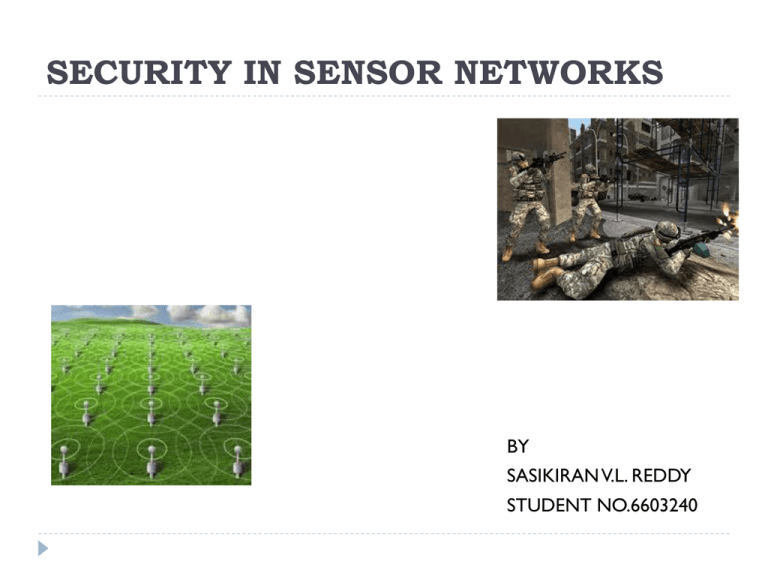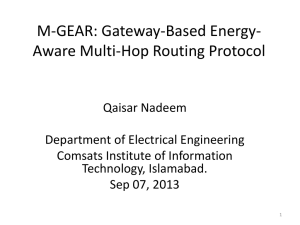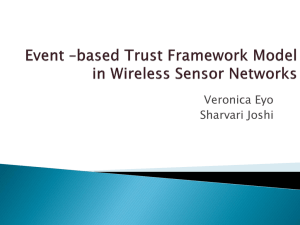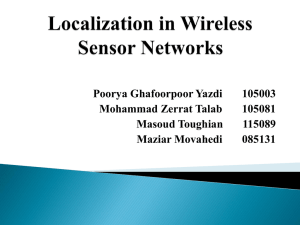SECURITY IN SENSOR NETWORKS
advertisement

SECURITY IN SENSOR NETWORKS BY SASIKIRAN V.L. REDDY STUDENT NO.6603240 OUTLINE 1.Introduction 2.Threats and Attacks 3.Protocols for Detection of Clone Attacks 3.1 Randomized Multicast(RM) 3.2 Line-Selected Multicast(LSM) 3.3 Randomized Efficient Distributed(RED) 4.Epidemic Data Survivability in Unattended WSNs 5.A Protocol for Securing Mobile Unattended WSNs 6. Secure Routing 7. Key Management 8.Cryptography 9.Conclusion 10.Questions INTRODUCTION Sensor networks have a large number of small sensor nodes with each consisting of some computing power, limited memory , various sensors with different communication capabilities. WSNs are assumed to be operated in real time environment and depending on the application it may be necessary that wireless message exchange be secure. CONSTRAINTS Transceiver Limited Storage Memory Sensors Embedded Processor Battery 1Kbps - 1Mbps, 3-100 Meters, Slow Computations Limited Lifetime NEED FOR SEPARATE SECURITY MECHANISMS Due to various limitations ( memory, power, battery) existing security mechanisms are poor fit for this domain. Threats to sensor networks are different from threats to mobile ad-hoc networks. Traffic model in WSNs is many to one unlike in mobile adhoc models where it is many to many. Sensor nodes are prone to failures due to harsh deployment environments. Number of nodes in WSNs can be several orders of magnitude higher than the nodes in the ad-hoc network. Sensor nodes may not have global identification. THREATS AND ATTACKS External Attacks: Attackers can capture sensor nodes and reprogram them Attackers can deploy nodes with larger computing resources such as laptops to attack sensor nodes Internal Attacks: Compromised nodes can steal secrets from encrypted data Compromised nodes can report wrong information Compromised nodes can report other nodes as compromised nodes. Compromised nodes can breach routing by introducing many routing attacks. Attacks 1.Denail Of Service(DOS) Main aim is to exhaust the resources of the nodes by sending unnecessary packets Some of the DOS attacks can be tampering, jamming,collision,exhausition,unfairness,blackholes etc., Methods to prevent DOS attacks –watchdog and reputation rating based scheme,Virtual Currency 2.Attacks on Information Wireless communication is vulnerable to eavesdropping, information may be altered, spoofed, replayed or vanished An attacker with high processing power and larger communication range (e.g., laptops) could attack several sensors at the same time to modify the actual information. Attacks(Cont.) 3.Sybil Attack: Picture A node uses the identities of more than one node for from (2) attacking distributed storage, routing mechanism, resource allocation etc., Difficult to detect the sybil node, radio resource testing is used to detect sybil nodes 4.Blackhole Attack: Node attracts all the traffic, once inserted between the communicating nodes, it can do any thing with the packets passing between them. Picture from (2) Attacks(Cont.) 5.Hello Flood Attack Attacker with high transmission power sends hello packets to various sensor nodes persuading that the attacker is the neighbor . As a result victim nodes tries to send the packets through the attacker 6.Wormhole Attack Attacker tunnels the message recorded at one location of the network to another location to make a fake that these two parts are very close Efficient authentication protocols can be used to detect the attack. Picture from (2) Attacks(Cont.) 7.Node Replication Attack(Clone Attack) Adversary captures nodes, acquires all the information stored inside .Therefore it may replicate the nodes and deploy them in the network. Can be detected using the Randomized multicast , Line Selected Multicast and RED protocols RED is highly efficient as for communications , memory and computations and has an improved detection probability compared to other distributed protocols Detection Of Clone Attacks Centralized protocols to detect a clone have a single point of failure and high communication cost Local protocols do not detect replicated nodes that are distributed in different parts of the network. Randomized multicast(RM) , Line-Selected Multicast(LSM) and Randomized ,Efficient and Distributed(RED) are self healing protocols which detects clones and exclude them from the network. General idea of all the above protocols is to distribute the location information to randomly selected nodes and the node that detects the existence of a node in two different locations is called a witness Detection Of Clone Attacks-RM When a node announces its location information , each of its neighbors sends digitally signed copy of the location information to randomly selected nodes with a probability p. If each neighbor selects O(n) destinations, at least one node will receive a pair of not coherent location claims which is the witness. Birthday Paradox implies location claims from a cloned node and its clone will collide with high probability High probability of detection of a clone Decentralized and randomized High communication costs (O(n) hops per node ) Detection Of Clone Attacks-RM Detection Of Clone Attacks-LSM In LSM when a node announces its location, every neighbor checks the signature in the claim and then with probability p forwards it to g>1 randomly selected destination nodes The location claim has to pass through several intermediate nodes and each node checks for the conflict and forwards the location claim towards the destination Node replication is detected by the node at the intersection of the two paths Decentralized and randomized High probability of intersection of two randomly drawn lines in a plane O(√n) signature verifications should be done and O(√n) location claims must be stored in memory which is impractical in real networks with thousands of nodes Detection Of Clone Attacks-LSM Detection Of Clone Attacks-RED Randomized, Efficient, Distributed (RED) is similar to RM in principle but witness is chosen pseudo randomly based on a network-wide seed. Every run of the protocol consists of 2 steps Step 1:A random value is broadcasted among all the nodes Step 2: Each node broadcasts its ID and location to its neighbors Each neighbor forwards the claim to a set of g>=1 (With probability p) Pseudo random function takes the input ID, rand and g Every node in the path (from claiming node to the witness destination) forwards the message to its neighbour nearest to the destination and signature verification is done only at the destination. LSM vs RED N=1000,g=1,p=0.1 LSM RED Data from (5) Epidemic Data Survivability in Unattended WSNs UWSNs are needed because sink cannot be present in the cases where sensors are deployed in hostile environments. Data survivability in UWSNs depends on the replication rate of the data and flooding should be avoided due to sensor resource constraints Controlled data replication can be achieved from the epidemic model SIS( Susceptible – Infected – Susceptible) Picture from (4) Epidemic Data Survivability in Unattended WSNs (Cont.) When a nodes receives the data, it is said to be infected and when an adversary tries to wipe the data, it moves back to the susceptible state. Sink captures the data as soon as a node in its range gets the infected. The goal of the adversary is to wipe the data such that the data does not reach the sink. Time is partitioned into rounds and in each round sensors with a replication approach tries to preserve the information and the attacker will try to compromise them with a final target to completely erase the information. Epidemic Data Survivability in Unattended WSNs (Cont.) Main aim of the model is to minimize the value of alpha(rate at which nodes are infected with data) preserving the data survivability and avoid the flooding of data in the network Selecting a maximum value for alpha such that alpha>beta(rate at which nodes move back to the susceptible state) is not a good choice because it floods the network and selecting a minimum value of alpha such that alpha>beta is also not a good choice A method of bounded difference is used to choose the lower bound on the data survivability. Securing Mobile Unattended WSNs In unattended WSN there is no real time communication with the sink , data collection is performed sporadically Goal: To provide intrusion resilience with out the aid of any trusted third parties Security is based entirely on the Hash function and the pseudo random number generator which is used to generate the key for encryption, we say that the sensor is secure in a particular round iff the adversary cannot compute the key generated by PRNG. Mobility Models: Random Jump(RJ): Speed is set such that sensor reaches the deployment area in one round Random Waypoint(RP): Speed is set such that sensor cover a distance no greater than m in one round Securing Mobile Unattended WSNs(Cont.) Protocol: Main idea is that any sensor that either has never compromised or regained security after compromise can act as a source of secure randomness to its peers At any round , sensors can be partitioned into three disjoint sets : Green: Either has never compromised or compromised and regained security, any green sensors can help its immediate neighbors to regain security Red: Currently compromised sensors that is located with in the range of the adversary. Green peers cannot help the Red ones to regain security Yellow: Sensors that has been compromised and has moved out of the range of the adversary. An yellow sensor can become Green if it receives the random value from the Green sensor Securing Mobile Unattended WSNs(Cont.) As shown below , when a green sensor enters into the range of a adversary ,it gets compromised and becomes a Red sensor . Since the sensors are mobile , when a Red sensors moves out of the range of adversary in the next round, it becomes Yellow and an Yellow sensor with the help of a Green sensor can turn into a Green sensor. Picture from (4) Securing Mobile Unattended WSNs(Cont.) Static sensors provide worst healing ratio if the same protocol is used. Picture from (4) S1,s2,s3 and s4 becomes yellow after adversary moves from position 1 to 2, s1 and s2 heal they both have a green neighbor, s3 and s4 does not heal as it has no green neighbor Secure Routing Multipath Routing: In a network where there are only small number of compromised nodes multipath routing schemes provide more reliable routing but communication overhead is more Reputation Based Schemes: This scheme requires neighbor nodes cooperation to control credit ,reputation. Main idea is that next hop in the routing is chosen based on link reliability and node reputation Broadcast Authentication: uTesla ,broadcast authentication protocol divides time into intervals of equal duration and assigns each time slot a corresponding key. Secure Routing Defense Against Attacks: PRSA (path redundancy based secure algorithm) uses alternate routing paths for each data transmission call to overcome the sensor network attack. Key Management 1.Key Pre-Distribution Schemes: Sensor nodes store some initial keys before deployment which are used to setup secure communication after deployment. This method is used in networks that have limited resources. Probability Schemes: Randomly preload each node with a subset of keys from a global key pool before deployment such that there exists one or more common keys between intermediate nodes Deterministic Schemes: Any two intermediate nodes share one or more pre distribution keys. The sharing of keys is done during the interval secure time Key Management(Cont.) 2.Hybrid Cryptography Schemes: An hybrid cryptographic scheme uses public key computations in the base station side and symmetric key computation in the sensor side 3.Key Management In hierarchy Networks: Key Distribution Center(KDC) maintains a key tree that will be used for key updates and distribution ,every sensor only store its keys on its key path that is from the leaf node up to the root. Cryptography Asymmetric key encryption are too expensive in terms of computation and energy cost Symmetric key encryption is better in terms of speed and low energy cost but it is difficult to deploy and manage Rijndael is suitable cipher when considering security and energy efficiency and MISTY1is good considering storage and energy efficiency Among asymmetric key encryption techniques SKIPJACK is reasonable and Diffie-Hellman is respectable Conclusion Cryptography Selection is fundamental to provide good security services, most approaches adopt symmetric key cryptography by introducing complex key management techniques Although more secure schemes are available to limit the effects of attacks ,attack detections are still needed . There are some secure routing protocols for ad-hoc networks but figuring out how to use them in sensor networks still need some work. Most secure routing protocols assume that sensors are stationary and it is highly needed to study secure routing protocols for mobile WSNs. Most security mechanisms assume that the base station is secure and robust however ,in some environments base station may be easily attacked References 1.Xiangqian Chen, Kia Makki, Kang Yen, and Niki Pissinou: “Sensor Network Security: A Survey, ” IEEE COMMUNICATIONS SURVEYS & TUTORIALS,VOL. 11, NO. 2, SECOND QUARTER 2009 2.Al-Sakib Khan Pathan , Hyung-Woo Lee, Choong Seon Hong : “Security in Wireless Sensor Networks: Issues and Challenges,” Advanced Communication Technology 2006,ICACT 2006. The 8th International Conference 3.Roberto Di Pietro, Nino Vincenzo Verde :“Epidemic Data Survivability in Unattended Wireless Sensor Networks,” Proceedings of the fourth ACM conference on Wireless network security ,2011 4.Roberto Di Pietro , Gabriele Oligeri , Claudio Soriente , Gene Tsudik: “Securing Mobile Unattended WSNs against a Mobile Adversary,” 2010 29th IEEE International Symposium on Reliable Distributed Systems 5.Mauro Conti, Roberto Di Pietro, Luigi V. Mancini, and Alessandro Mei: ” Distributed Detection of Clone Attacks in Wireless Sensor Networks,” IEEE TRANSACTIONS ON DEPEDABLE AND SECURE COMPUTING ,2010 Questions? Question 1 What are the overheads caused by Line-Selected Multicast (LSM) protocol for detecting clone attacks and how are they eliminated using Randomized ,Efficient and Distributed (RED) protocol. Figure from 5 Question 1(Cont.) Ans: Overheads caused by LSM: 1.Memory Overhead-claim messages should be saved in all the intermediate nodes on the route to the destination. 2.Computation Overhead-Signature verification should be done at all the intermediate nodes RED: 1.RED doesn’t have a memory overhead as the claim messages will be saved only at the destination. 2.In RED signature verification is done by the neighbors and the destination nodes only . Question 2 Assume that the sensors in the network are all static and adversary is mobile. Adversary is in position p1 at round r-1 and jumps to position p2 at round r. All the sensors that were red at round r-1 become yellow at round r . Green: Either has never compromised or compromised and regained security Red: Currently compromised sensors that is located with in the range of the adversary Yellow: Sensors that has been compromised and has moved out of the range of the adversary. Which type of sensors have worst healing ratio ,static or mobile? and why? In the following network which nodes can heal? Question 2 (Cont.) Ans. Static sensors have the worst healing effect .If the sensors are mobile ,they jump in each round so that the probability that they can meet a green sensor is high but in static sensor ,once a sensor is compromised, it cannot be healed if there is no green sensor in its range. Nodes 1,2,3,4 and 5 gets compromised and nodes 3 and 5 can heal as they have a green neighbor. Question 3 What are the security constraints in a WSN and why do we need separate security mechanisms for sensor networks? Ans: Constraints: 1.Low Transmission Power 2.Limited Memory 3.Limited Battery Life Time 4.Slow Computations Need for a Separate Security Mechanism 1.Various Limitations 2.Threats are different from ad-hoc networks 3.Harsh Deployment Environments 4.Number of nodes are very high THANK YOU Email:svepa045@uottawa.ca








